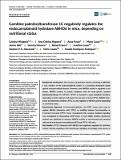Por favor, use este identificador para citar o enlazar a este item:
http://hdl.handle.net/10261/236824COMPARTIR / EXPORTAR:
 SHARE SHARE
 CORE
BASE CORE
BASE
|
|
| Visualizar otros formatos: MARC | Dublin Core | RDF | ORE | MODS | METS | DIDL | DATACITE | |

| Título: | Carnitine palmitoyltransferase 1C negatively regulates the endocannabinoid hydrolase ABHD6 in mice, depending on nutritional status |
Autor: | Miralpeix, Cristina; Reguera, Ana Cristina; Fosch, Anna; Casas, Maria; Lillo, Jaume; Navarro, Gemma; Franco, Rafael; Casas, Josefina CSIC ORCID ; Alexander, Stephen P.H.; Casals, Núria; Rodríguez‐Rodríguez, Rosalía | Palabras clave: | ABHD6 CPT1C Endocannabinoid signalling Fasting Hippocampus Hypothalamus malonyl–CoA |
Fecha de publicación: | 12-feb-2021 | Editor: | British Pharmacological Society | Citación: | British Journal of Pharmacology 178 (7): 1507-1523 (2021) | Resumen: | Background and Purpose The enzyme α/β‐hydrolase domain containing 6 (ABHD6), a new member of the endocannabinoid system, is a promising therapeutic target against neuronal‐related diseases. However, how ABHD6 activity is regulated is not known. ABHD6 coexists in protein complexes with the brain‐specific carnitine palmitoyltransferase 1C (CPT1C). CPT1C is involved in neuro‐metabolic functions, depending on brain malonyl–CoA levels. Our aim was to study CPT1C–ABHD6 interaction and determine whether CPT1C is a key regulator of ABHD6 activity depending on nutritional status. Experimental Approach Co‐immunoprecipitation and FRET assays were used to explore ABHD6 interaction with CPT1C or modified malonyl–CoA‐insensitive or C‐terminal truncated CPT1C forms. Cannabinoid CB1 receptor‐mediated signalling was investigated by determining cAMP levels. A novel highly sensitive fluorescent method was optimized to measure ABHD6 activity in non‐neuronal and neuronal cells and in brain tissues from wild‐type (WT) and CPT1C–KO mice. Key Results CPT1C interacted with ABHD6 and negatively regulated its hydrolase activity, thereby regulating 2‐AG downstream signalling. Accordingly, brain tissues of CPT1C–KO mice showed increased ABHD6 activity. CPT1C malonyl–CoA sensing was key to the regulatory role on ABHD6 activity and CB1 receptor signalling. Fasting, which attenuates brain malonyl–CoA, significantly increased ABHD6 activity in hypothalamus from WT, but not CPT1C–KO, mice. Conclusions and Implications Our finding that negative regulation of ABHD6 activity, particularly in the hypothalamus, is sensitive to nutritional status throws new light on the characterization and the importance of the proteins involved as potential targets against diseases affecting the CNS. | Versión del editor: | https://doi.org/10.1111/bph.15377 | URI: | http://hdl.handle.net/10261/236824 | DOI: | 10.1111/bph.15377 |
| Aparece en las colecciones: | (IQAC) Artículos |
Ficheros en este ítem:
| Fichero | Descripción | Tamaño | Formato | |
|---|---|---|---|---|
| bph.15377.pdf | Artículo principal | 8,72 MB | Adobe PDF |  Visualizar/Abrir |
CORE Recommender
SCOPUSTM
Citations
8
checked on 13-abr-2024
WEB OF SCIENCETM
Citations
9
checked on 26-feb-2024
Page view(s)
68
checked on 19-abr-2024
Download(s)
140
checked on 19-abr-2024
Google ScholarTM
Check
Altmetric
Altmetric
NOTA: Los ítems de Digital.CSIC están protegidos por copyright, con todos los derechos reservados, a menos que se indique lo contrario.
